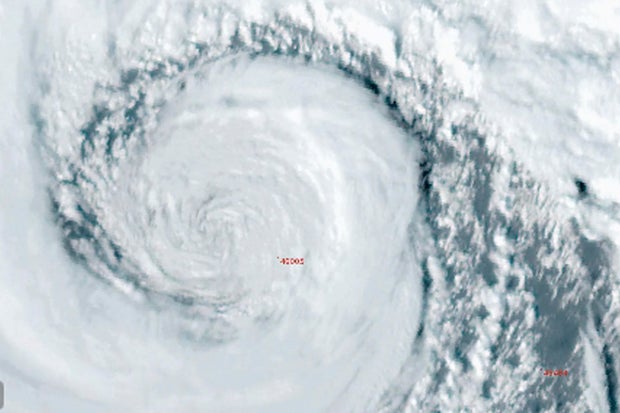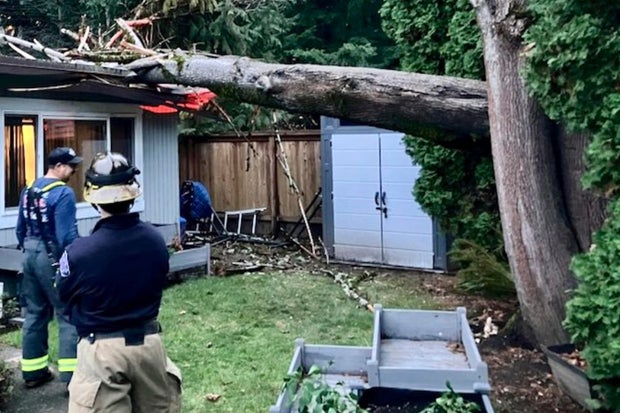A big storm swept across the northwestern US, lashing the region with high winds and rain, causing widespread power outages and downing trees, killing at least one person.
The Weather Prediction Center issued excessive rainfall risks through Friday and hurricane force warnings were in effect as the strongest atmospheric river — a large plume of moisture — that California and the Pacific Northwest saw this season engulfed the region. The storm system that began hitting Tuesday is considered a bomb cyclonewhich occurs when a cyclone rapidly intensifies.
National Weather Service Portland via AP
Falling trees hit homes and littered roads in northwest Washington. In Lynnwood, Washington, a woman died Tuesday evening when a large tree fell on a homeless encampment, South County Fire said in a statement about X. In Seattle, a tree fell on a vehicle, temporarily trapping someone, the Seattle Fire Department said. . The agency later said the person was in stable condition.
“Trees are falling and falling on houses all over the city,” the fire department in Bellevue, about 10 miles east of Seattle, posted on social platform X. “If you can, get to the lowest floor and stay away from windows Don’t go outside if you can avoid it.”
A fire department in Washington state posted images to X early Wednesday of some of the damage crews experienced:
Eastside Fire & Rescue via AP
Early Wednesday, it was reported that more than 600,000 homes in Washington state were without power on PowerOutage.us. The number of outage reports fluctuated wildly Tuesday evening, likely in part because various weather and utility companies struggled to report information about the storm due to internet outages and other technical issues. It was not clear whether that figure was correct. More than 4,000 people had lost power in Oregon and nearly 15,000 in California. that Puget Sound Energy said in a statement early Wednesday morning that they have nearly half a million customers without power and are expecting a “multi-day outage.”
CBS Seattle affiliate KIRO-TV reports that Puget Sound Energy said in a statement early Wednesday morning that the nearly half a million customers without power should expect a “multi-day outage.”
According to the National Weather Service in Seattle, maximum wind speeds were around 8 p.m. in Canadian waters, where gusts of 100 miles per hour were reported off the coast of Vancouver Island. Wind gusts of up to 75 miles per hour were reported along the Oregon coast Tuesday evening, according to the National Weather Service in Medford, Oregon, while winds of 77 miles per hour were recorded on Mount Rainier in Washington.
The National Weather Service warned people on the West Coast about the danger posed by trees during high winds, posting on X: “Stay safe by avoiding outdoor rooms and windows and by using caution while driving.”
Flood and high wind warnings were in effect in Northern California, with up to 8 inches of rain forecast for parts of the San Francisco Bay Area, North Coast and Sacramento Valley. According to the National Weather Service Weather Prediction Center, 12-16 inches were forecast for far northern California and far southwestern Oregon through Friday. Dangerous flash floods, rockslides and debris flows were expected.
A winter storm watch was issued for the northern Sierra Nevada above 3,500 feet, where 18 inches of snow was possible over two days. Wind gusts could reach up to 120 km per hour in mountain areas, forecasters say.
The National Weather Service has issued a flood warning for parts of southwestern Oregon through Friday evening, while rough winds and seas shut down a ferry route in northwest Washington between Port Townsend and Coupeville.
A blizzard warning was issued for most of Washington’s Cascades, including Mount Rainier National Park, with up to a foot of snow and wind gusts up to 60 mph, according to the weather service in Seattle. Traveling over passes can be difficult, if not impossible.
The Weather Prediction Center said heavy, wet snow would fall along the Cascades and in far Northern California. accumulating at a rate of two to three centimeters per hour. That, along with wind gusts of up to 65 mph, could result in whiteout/blizzard conditions and “nearly impossible travel at pass level,” the center said.








